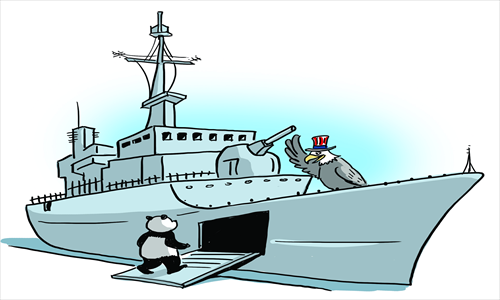RIMPAC chance for real military exchanges

Illustration: Liu Rui/GT
Chinese Ministry of National Defense spokesman Geng Yansheng updated preparations Thursday on China's participation in the Rim of the Pacific exercises (RIMPAC) in 2014, saying that China holds a positive attitude toward military cooperation with the US in various fields.
The US-dominated RIMPAC is the most influential military drill in the Pacific region. So far, most influential military powers have attended the exercises, and China's announcement of its participation in 2014 has caught global attention.
This is a reflection of China's confidence in its military strength. Since the Chinese navy visited the South Asian region in the 1980s, its strength has been greatly boosted, as demonstrated through the implementation of escort missions in the Gulf of Aden against pirates, and the 118-day voyage of Chinese hospital navy ship, the Peace Ark, to deliver medical assistance to residents of neighboring countries.
By attending the 2014 RIMPAC, the Chinese navy will enter deep into Pacific regions for joint military drills, where China will display its confidence in its military strength.
Although China's military cooperation with other countries has been enhanced in recent years, such contact between China and the US has been limited and advances only in small steps.
Joint drills have been extended from land troops to navies, but a real joint exercise between China and the US hasn't yet taken place. China's participation in the 2014 RIMPAC could be seen as a breakthrough in China's booming military diplomacy after it began the reform and opening-up process.
The 2014 RIMPAC will be an important step for boosting adjustment in Sino-US military ties. The US is the biggest military power in the world, while China is the biggest developing country. With the global spotlight focusing on the Asia-Pacific region, the two powers are confronted with how to build up their military ties.
The Sino-US military relationship has been stumbling for many years with a few accidents further damaging mutual trust, like the 1993 Yinhe incident, in which the container ship Yinhe was alleged to be carrying materials for chemical weapons to Iran and was forcefully checked in Saudi Arabia by a joint Saudi-US team. The 2001 US-China aircraft collision incident over the South China Sea provides another example.
Currently, the US controls Europe security pattern through NATO, but with its global strategic focus shifting eastward to the Asia-Pacific region, the US has to build up a new military geometry in the region. One of its obstacles is how to place China in this geometry and define China's role.
The invitation to the 2014 RIMPAC is a measure to make clear China's strategic demands and to get to know better Beijing's military strength. It's foreseeable that as the US is accelerating its steps toward having a new military pattern in the Asia-Pacific region, exchanges between China and the US will be on the rise.
The Sino-US military relationship has been entangled in a growing security dilemma in recent years. The US worries that China's military modernization will challenge its dominant position, while China believes intensifying relations between the US and its Pacific allies aim to step up the containment of China.
In such circumstances, a major breakthrough between China and the US in military communication will wield significant influence.
The 2014 RIMPAC opens a window for the US and the world to know more about the Chinese military, which further helps to reduce the risk of conflict between the two and cool down hot issues in surrounding areas. It will also create more opportunities for exchanges in the future. From these perspectives, the 2014 RIMPAC has both symbolic and practical significances.
The author is a professor at the PLA University of National Defense. opinion@globaltimes.com.cn